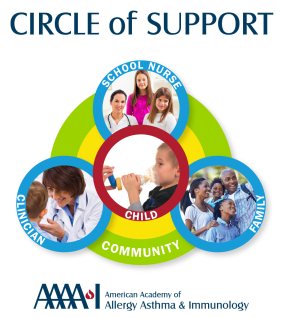SA³MPROTM Establishing a Circle of Support
 The Circle of Support is a communication network centered around the child, consisting of clinicians, school nurses, and families. This communication network allows for patient centered education and improved asthma management by all members of the circle of support.
The Circle of Support is a communication network centered around the child, consisting of clinicians, school nurses, and families. This communication network allows for patient centered education and improved asthma management by all members of the circle of support.
Role of the Clinician
Clinicians who care for children with asthma have a unique obligation to coordinate asthma care with the schools. Aside from routine clinical care of asthma, health care providers must educate the family and child about the need for an Asthma Action Plan (AAP) in school, and should support the school nurse that is providing school-based asthma care.
Asthma Action Plan
A key step in coordinating asthma care is the creation of the Asthma Action Plan and transmitting it to schools. A recommended AAP is provided in this toolkit, English, Spanish and a variety of other versions.
For clinicians who wish to adapt their existing forms for use, we have provided the Essential Features of a School-related Asthma Action Plan and an Asthma Action Plan with Essential Features Highlighted. If needed, the School Supplementary Treatment Orders Form can be sent with the Asthma Action Plan.
To further recommend that clinicians engage in bidirectional communication with patients, families, and school nurses we recommend utilizing the Asthma Visit Checklist for the Provider.
Communication with Patients, Families, and School Staff
Ideal communication between providers and school nurses should be accessible, bi-directional, and use simple standardized processes that are customizable for individual students (see the Essential Features of a School-related Asthma Action Plan).
In addition to completing and transmitting an AAP with associated authorization forms, prescriptions and education regarding school based asthma care need to be provided to the patient and school nurse (see the School Supplementary Treatment Orders Form). By integrating the school nurse in the circle of communication and asthma care, the clinician should strive to actively involve the school nurse as part of the asthma care team.
We encourage clinicians and school nurses to engage local resources such as breathmobile programs, school based health centers, and mobile clinics as important conduits of communication amongst clinicians, patient, families and school nurses.
Asthma Action Plan for Home and School
Arabic
Dutch
English
French
German
Italian
Karen
Russian
Somali
Spanish
Traditional Chinese
Ukranian
School Supplementary Treatment Orders
Arabic
Dutch
English
French
German
Italian
Karen
Russian
Somali
Spanish
Traditional Chinese
Ukranian
Asthma Visit Checklist for the Provider
Arabic
Dutch
English
French
German
Italian
Karen
Russian
Somali
Spanish
Traditional Chinese
Ukranian
Essential Features of a School-related Asthma Action Plan
Arabic
Dutch
English
French
German
Italian
Karen
Russian
Somali
Spanish
Traditional Chinese
Ukranian
Role of the School Nurse
School nurses are an essential part of the health care team since they often coordinate care for students with asthma. School nurses are uniquely positioned to provide direct care, adherence counseling, and education, and can provide an important link to community based care for children with asthma.
We encourage school nurses to use the School Nurse Asthma Care Checklist to ensure care coordination for asthma care in school is complete.
School Nurse Asthma Care Checklist (National Association of School Nurses*)
Arabic
Dutch
English
French
German
Italian
Karen
Russian
Somali
Spanish
Traditional Chinese
Ukranian
Role of the Family
Families play an essential role in implementing the Asthma Action Plan at home. In addition, they continue to play an important role in advocating for the child and communicating the needs of the child effectively to both school nurses and clinicians.
We recommend using the Asthma Visit Checklist for the Child and Family to ensure patients and families receive important patient education and are empowered to become advocates for their health care.
Asthma Visit Checklist for the Child and Family
Arabic
Dutch
English
French
German
Italian
Karen
Russian
Somali
Spanish
Traditional Chinese
Ukranian
Role of the Community
In addition to the clinicians, school nurses, and families directly involved in supporting the child with asthma, the health system and school play an important role in the success of the School-Based Allergy, Asthma and Anaphylaxis Management Program.
Buy-in from health system and school leadership will help ensure that adequate support and resources are provided to the program to help ensure its success.
5/22/2023